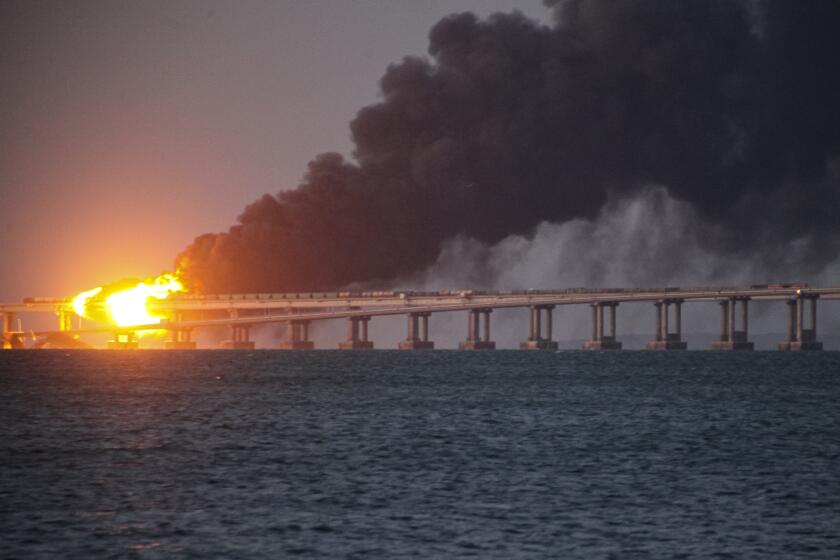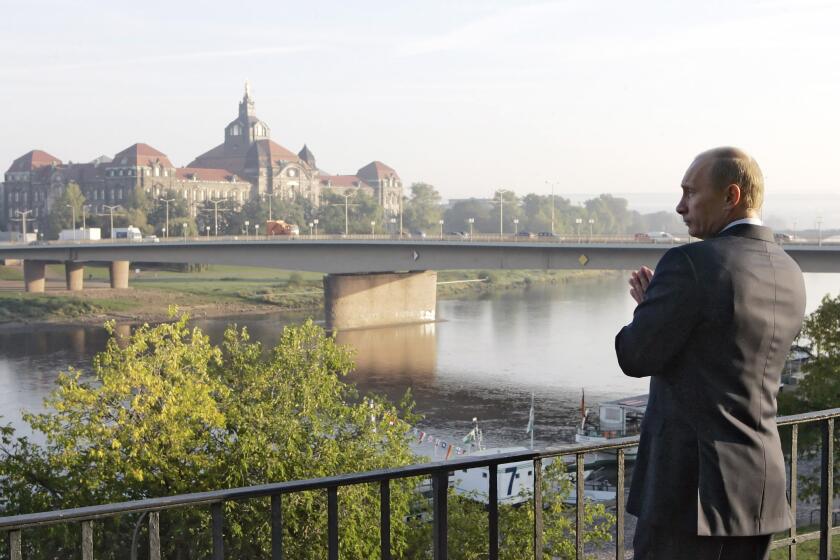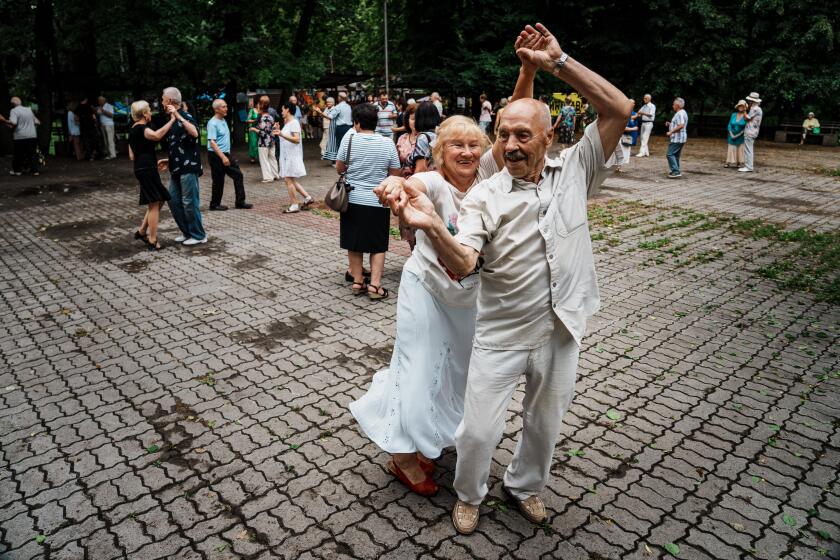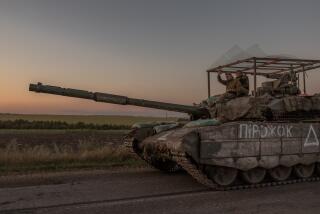The Crimean peninsula is both a playground and a battleground, coveted by Ukraine and Russia
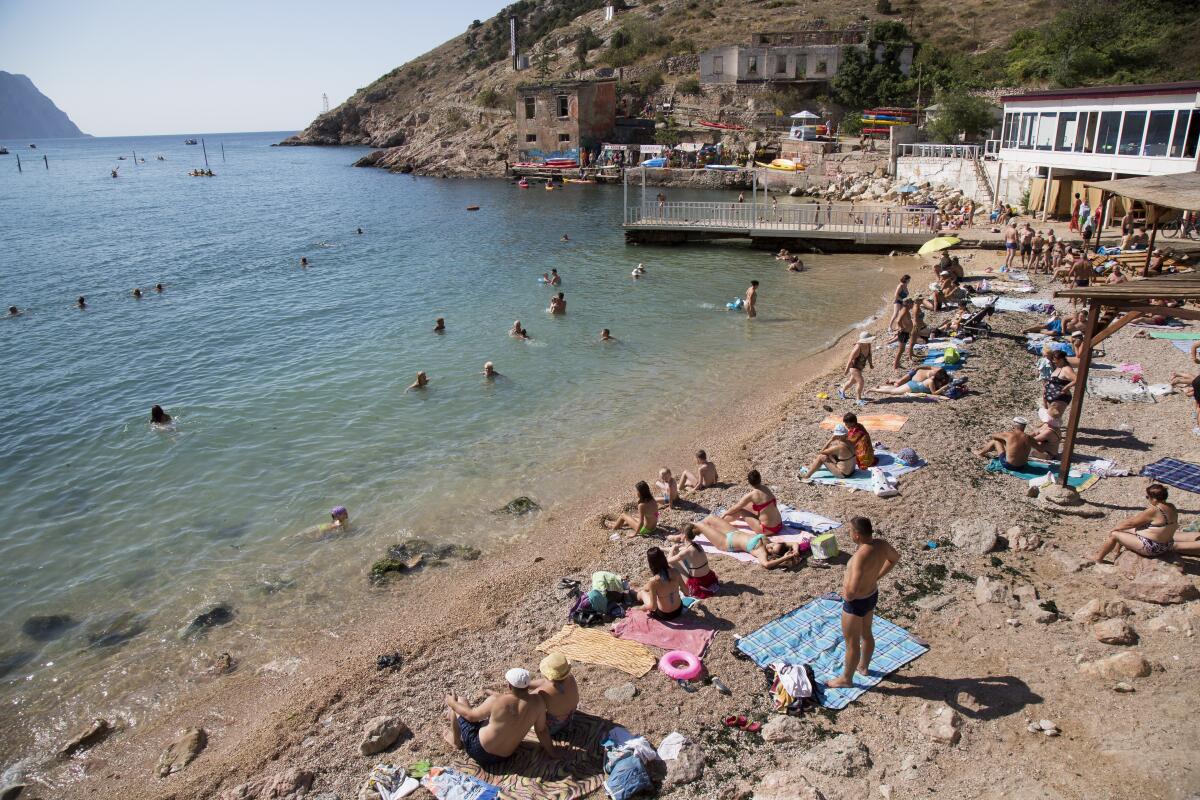
- Share via
TALLINN, Estonia — Its balmy beaches have been vacation spots for Russian czars and Soviet general secretaries. It has hosted history-shaking meetings of world leaders and boasts a strategic naval base. And it has been the site of ethnic persecutions, forced deportations and political repression.
Now, as Russia’s war on Ukraine enters its 18th month, the Crimean peninsula is again both a playground and a battleground, with drone attacks and bombs seeking to dislodge Moscow’s hold on the territory and bring it back under Kyiv’s authority, no matter how loudly the Kremlin proclaims its ownership.
Ukrainian President Volodymyr Zelensky has vowed to retake the diamond-shaped peninsula that Russia’s Vladimir Putin illegally annexed in 2014.
For both presidents, backing off Crimea is hardly an option.
Moscow deployed troops and weapons there, allowing Russian forces to quickly seize large parts of southern Ukraine when the war began in 2022. Kyiv says the militarization of Crimea threatens all countries in the Black Sea region.
Ukraine sees Crimea, the strategic peninsula illegally annexed by Russia nearly nine years ago, as potentially within its grasp.
‘Crimea is ours!’
Putin’s annexation in 2014 was quick and bloodless. While Ukraine was still grappling with the aftermath of the uprising that forced pro-Moscow President Victor Yanukovich from office, men in military uniforms without insignia took control of Crimea.
They helped orchestrate a referendum on the peninsula, and pro-Kremlin authorities said the results showed an almost unanimous desire of its residents to become part of Russia.
Putin’s popularity soared. His approval ratings, which had been declining, soared from 65% in January of that year to 86% in June, according to the Levada Center, an independent Russian pollster.
“Krym nash!” — or “Crimea is ours!” — became a rallying cry in Russia. But only a handful of countries, including North Korea and Sudan, recognized the move.
Putin has called Crimea “a sacred place,” and has prosecuted those who publicly argue it is part of Ukraine. Zelensky has repeatedly said that “Russia won’t be able to steal” the peninsula.
A strategic asset
Crimea’s unique position in the Black Sea makes it a strategically important asset for whoever controls it, and Russia has spent centuries fighting for it.
Crimea was home to Turkic-speaking Tatars when the Russian empire first annexed it in the 18th century. It briefly regained independence as a Tatar republic two centuries later before becoming swallowed by the Soviet Union.
In 1944, Soviet dictator Josef Stalin deported nearly 200,000 Tatars, or about a third of Crimea’s population, to Central Asia, 2,000 miles to the east. Stalin had accused them of collaborating with Nazi Germany — a claim widely dismissed by historians. An estimated half of them died in the next 18 months of hunger and harsh conditions.
Soviet leader Nikita Khrushchev transferred Crimea to Ukraine in 1954 to commemorate the 300th anniversary of the unification of Moscow and Kyiv. But that symbolic move backfired in 1991 when the U.S.S.R. collapsed and the peninsula became part of newly independent Ukraine.
Russian President Vladimir Putin’s KGB years in East Germany offer a window into his crackdown on protests, war on Ukraine and yearning for empire.
“For the majority of Russians, as well as for the Russian political elite, Crimea has always been perceived as given to Ukraine unfairly. Crimea has always been perceived as Russian,” Tatiana Stanovaya, a senior fellow at the Carnegie Russia Eurasia Center, told the Associated Press.
Russia kept a foot in the door: Its Black Sea Fleet had a base in the city of Sevastopol, and Crimea — as part of Ukraine — continued to host it.
The base was of major military value to Moscow, and that was likely a key factor for the Kremlin’s decision to annex the peninsula in 2014, according to Graeme Robertson of the University of North Carolina-Chapel Hill.
“Sevastopol really matters for the Russian fleet and for access to the Mediterranean, and for Russia to be a power that’s able to close the Black Sea and exercise control over Ukraine’s economic viability and political viability,” Robertson said in an interview. “I think that is, at the end of the day, why the annexation took place.”
Repressions against the Crimean Tatars continued under Putin, despite Moscow’s denials of discrimination. They strongly opposed the annexation, and an estimated 30,000 of them fled the peninsula between 2014 and 2021.
Some who stayed faced a relentless crackdown by Russia, which rejects accusations of discrimination but nevertheless banned the Tatars’ main representative body and some religious groups. About 80 Tatars have been convicted in the crackdown, Amnesty International reported in 2021, and 15 activists have gone missing.
How do citizens of Kyiv cope with the sleep deprivation and stress from Russia’s war on Ukraine? Some push it down, some try yoga or dancing.
Crimea’s emotional value
Beyond its strategic value, Crimea has a special resonance for Russians — “an emotional and almost sort of quasi-religious kind of thing,” said Sam Greene, a professor of Russian politics at King’s College London.
Some of it may be based on its history.
Sevastopol was a preferred holiday destination for Nicholas II, the last Russian czar, and his family. The southern town of Yalta was the prime holiday destination during Soviet times, with many sanatoriums built in and around it. It drew worldwide attention when Stalin, U.S. President Franklin D. Roosevelt and British Prime Minister Winston Churchill met there in 1945 to discuss the fate of Germany and Europe after World War II.
Foros, another resort town near Sevastopol, held the state dachas of Soviet leaders. President Mikhail Gorbachev was vacationing there in 1991 when hard-liners opposed to his rule put him under house arrest during a failed coup d’etat.
When Greene and Robertson conducted a survey of Russians both before and after Putin seized Crimea in 2014, they noted a change in the respondents’ demeanor.
“All of a sudden, they felt that corruption was less of an issue in the country,” Greene said. “And they were optimistic about the economy, both personally, in terms of their own welfare, and how the country as a whole was likely to do in the future. And their memories of the 1990s have improved.”
This optimism began deflating in 2018. Putin’s popularity fell to under 70% in summer 2018, after he was reelected and made unpopular economic moves such as raising the retirement age.
The full-scale war in Ukraine in 2022 reinstated that rallying effect to a degree, Greene says, but if the Kremlin loses Crimea or requires a significant effort to keep it, people “might come to the conclusion that Putin is not the man for the job.”
Stanovaya, the political analyst, says few in Moscow believe Ukraine is capable of retaking Crimea, even with the increased attacks that include those on Putin’s prized asset — the Kerch Bridge linking Crimea to Russia, which was struck in October and again last month — and other targets, such as an ammunition depot on July 22.
“It is, of course, irritating, but it is viewed as political investments directed at [Ukraine’s] domestic audience and at the West,” she said.
Some ordinary Russians seem unbothered as well — many still flocked to Crimea’s resorts this summer. After July’s attack on the bridge, Russian media found multiple vacationers undeterred by authorities telling them to travel to the peninsula through the occupied parts of Donetsk, Zaporizhzhia and Kherson regions of Ukraine, even though all three are on the front line of the fighting.
Still, tourism has suffered, with some of the peninsula’s beaches turned into fortifications and some hotels and guest houses reporting vacancies.
Even far from Ukraine’s front lines, military funerals set off waves of mourning. ‘You can’t see an end to it,’ one chaplain says as the war drags on.
Ukraine’s stake in Crimea
By the time of the 2014 Russian annexation, Crimea had been part of Ukraine for 60 years. Leonid Kravchuk, the first president of independent Ukraine, said Kyiv had invested some $100 billion into the peninsula between 1991 and 2014.
It has become part of Ukraine’s identity as well.
Before the invasion, Zelensky was focused on diplomatic efforts to get Crimea back, but after Russian troops rolled across the border, Kyiv started publicly contemplating retaking the peninsula by force.
It won’t be easy, as “Russia seeks to deploy the maximum number of different types of weapons there,” military analyst Roman Svytan told AP, because its position between the Black Sea and the Azov Sea gives Moscow “the military key to the entire region.”
From a security perspective, Ukraine needs Crimea to be fully independent and have control over activities in the Black Sea, Robertson said.
“Any deal that would cede Crimea to the Russians as part of a peace settlement would be very hard to sell in Ukraine,” he added.
So it’s very important for Kyiv “to signal to the West that this is a war about getting all of Ukraine back,” Robertson said. “This is not about getting eastern Ukraine and southern Ukraine and then cutting a deal.”
Associated Press writer Yuras Karmanau in Tallinn, Estonia, contributed.
More to Read
Sign up for Essential California
The most important California stories and recommendations in your inbox every morning.
You may occasionally receive promotional content from the Los Angeles Times.
